Playing the banjo is an incredible experience that brings joy and allows for boundless creativity. One of the fundamental aspects of mastering this unique instrument is understanding the importance of wearing banjo picks correctly. These small yet powerful tools hold the key to shaping the sound you produce, enabling a clear and resonant tone that truly captivates listeners. In this comprehensive guide, we will walk you through every step of the process, ensuring that you have a deep understanding of how to properly wear banjo picks. By following these instructions meticulously, you will unlock the full potential of your banjo playing experience, creating beautiful music that resonates with both yourself and your audience. Get ready to embark on a journey of musical exploration and self-expression!
Wearing Picks
To begin wearing your banjo picks, it’s important to first identify the three types: the thumb pick, and two finger picks. The thumb pick should securely wrap around your thumb, with the pick extending out from the side at a comfortable angle. Make sure it fits snugly but not overly tight, allowing for ease of movement.
For the finger picks, carefully place them on your index and middle fingers. Position them on the pads of your fingers, extending out slightly over your nails. Adjust the position and tightness until they feel just right for you. Remember, the picks should follow the natural direction of your fingers when you’re playing, ensuring optimal control and precision.
As you experiment with different angles, you’ll discover a position that produces the sound you prefer. Each player has their own unique preference, so take your time to find what works best for you. Don’t be afraid to practice strumming the banjo to get accustomed to the feel of the picks on your fingers. With patience and dedication, you’ll eventually establish a comfortable and effective setup that enhances your banjo playing experience.[1]
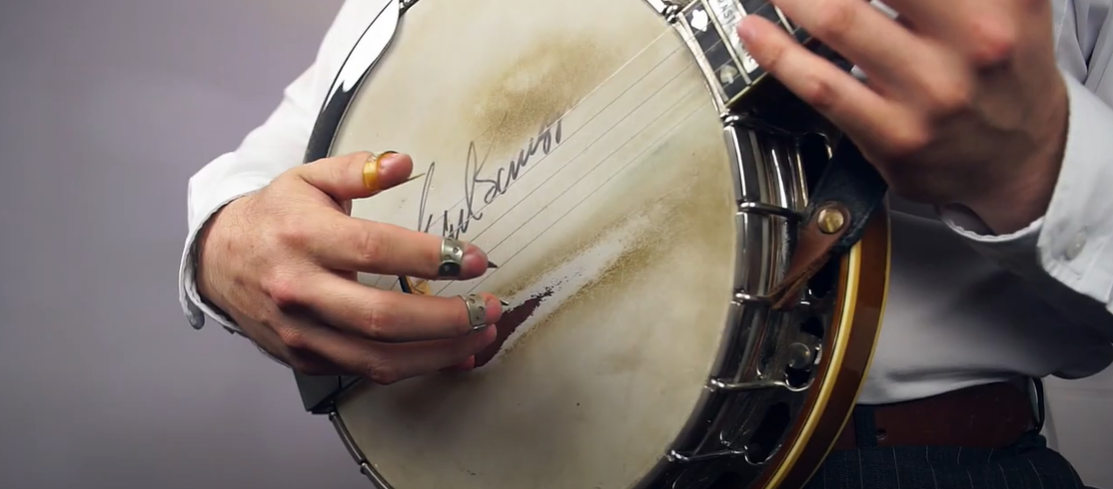
Hold the Banjo Comfortably
The next crucial step after wearing your picks is to hold the banjo correctly. Holding your banjo comfortably and with proper technique will not only allow for a better sound output but also prevent strain during prolonged periods of play. To achieve this, start by finding a comfortable sitting position that promotes good posture. Keep your back straight, but relaxed, and avoid slouching.
Now, let’s focus on your right hand. Place your right hand over the drumhead, with your fingers naturally extended towards the strings. Your hand should hover over the strings, allowing for fluid movement and precise strikes. Position the thumb pick aligned with the fifth string, ready to pluck or strum it, while the finger picks are positioned to strike the remaining strings. This hand position enables you to produce clear and distinct notes, enhancing the overall sound quality.
Lastly, ensure that the banjo’s body is close to you, but not pressed against you. This allows for optimal resonance and sound projection. Remember, comfort is key to producing a good sound and enjoying your playing experience. Taking the time to establish a proper and comfortable banjo-holding technique will greatly enhance your playing abilities and overall enjoyment of this wonderful instrument.[1]
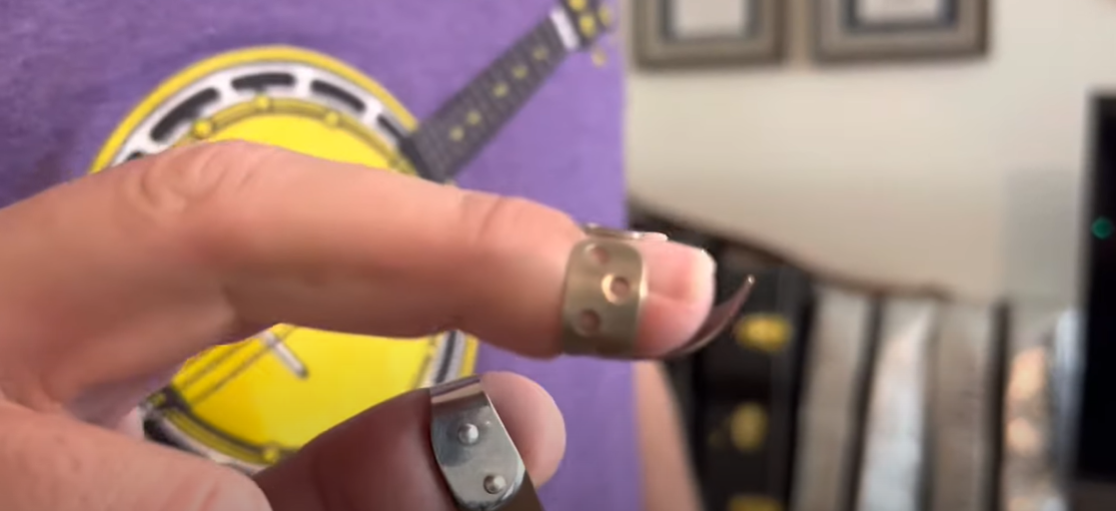
Find a Good Right Hand Position
Correct right hand positioning is crucial for banjo players to achieve optimal sound production. In addition to wearing your picks correctly and holding the banjo comfortably, the position of your right hand plays a significant role in controlling rhythm and tone.
To start, rest your arm on the edge of the banjo, allowing your hand to float above the strings. Orient your hand so that the picks align with the strings they will play. The thumb pick should be positioned over the fifth string, while the finger picks should be aligned with the other strings. Keep your fingers relaxed, slightly curled, and ready to strike the strings with precision.
Some players prefer to rest their ring and little fingers on the banjo head to ensure stability, although this is a matter of personal preference. The key is to maintain a relaxed hand and arm, promoting fluidity of movement. As you play, strive to keep your hand relatively stationary, with most of the movements originating from your fingers and thumb.
Remember, practice makes perfect. Take the time to experiment with different hand positions and movements until you find the one that not only produces the best sound but also provides the utmost comfort during your banjo playing journey.[1]
Which Finger to Play With?
Correctly identifying which fingers to play with is a significant aspect of creating beautiful banjo music. The thumb, index, and middle fingers are generally used when playing the banjo with picks. The thumb pick is responsible for playing the fifth string and also the fourth string in some cases. Meanwhile, your index and middle fingers, each adorned with a finger pick, will typically play the first, second, and third strings.
To master the art of banjo playing, it’s essential to maintain flexibility in your approach and adapt to the requirements of the piece you’re playing. Experiment with different finger placements and techniques to find what feels most comfortable and produces the desired sound. As always, consistent practice will help you develop dexterity and precision, enhancing your overall banjo playing skills. So, keep strumming, picking, and exploring the vast possibilities of this fascinating instrument![2]
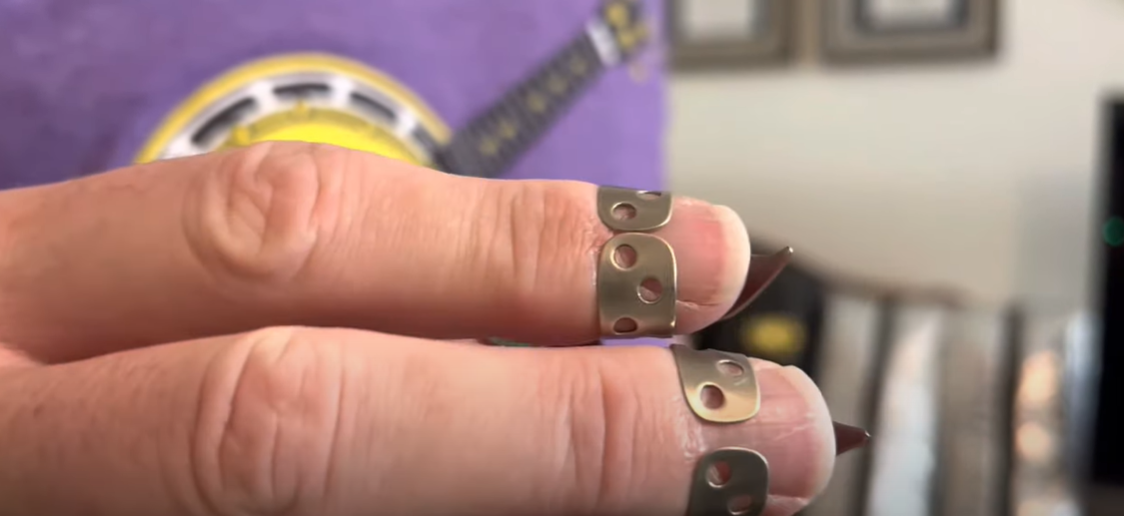
Fret some strings with the Left Hand
While the right hand is responsible for maintaining rhythm and tone on the banjo, the left hand plays an equally crucial role in manipulating the pitch of the instrument. This is achieved through a technique called fretting, which involves pressing down on the strings against the fretboard with your fingers.
To begin, position your thumb on the back of the neck to provide a stable base for your other fingers to fret the strings. Make sure your thumb is roughly opposite your middle finger, as this will help maintain optimal balance and control. Next, use your index, middle, and ring fingers to apply pressure on the strings between the frets. Each fret represents a half-step in musical terms, allowing you to produce different notes.
It is important to press the strings down just behind the frets, rather than directly on them, in order to avoid muted or buzzing sounds. Apply just enough force with your fingers to produce a clean sound, without straining your hand. It is worth noting that the precise positioning and pressure you apply can greatly impact the sound produced, so feel free to experiment with different techniques until you find a style that suits you.
Remember, mastering this skill requires practice and dedication. Keep at it, and soon enough, you’ll be fretting strings like a seasoned pro![2]
What type of finger picks should you buy?
Choosing the right finger picks is crucial for banjo players as it can significantly impact both comfort and sound. With a wide array of picks available in the market, each having its own unique characteristics, it’s important to consider various factors.
One of the most common types of picks is metal picks, known for their durability and ability to produce a bright, crisp tone. These picks are ideal for playing styles like bluegrass that require a distinct, sharp sound. On the other hand, plastic picks offer a softer, warmer tone and are often more comfortable for beginners due to their flexibility.
In addition to the material, the size, shape, and thickness of the pick can also influence the overall playing experience. Some picks have a more pronounced curve, which may feel more natural for certain players. The thickness of the pick is another factor to consider, as thicker picks tend to produce a fuller, louder sound, while thinner ones yield a lighter, more delicate tone.
Ultimately, finding the best pick for you is a matter of personal preference. It’s highly recommended to try out different types of picks to determine the one that feels comfortable on your fingers and produces the sound that suits your playing style the most. By exploring and experimenting with different picks, you can enhance your banjo playing experience and discover the perfect match for your musical journey.[2]
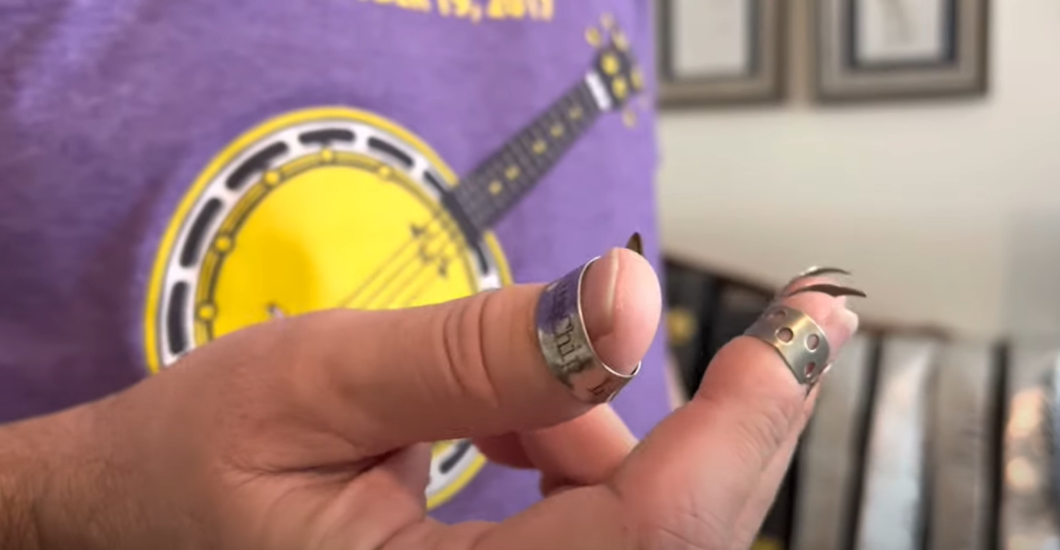
FAQ
How are banjo picks worn?
Properly wearing banjo picks is crucial for ensuring optimal comfort, preventing potential injury, and producing a rich and resonant sound. When it comes to the thumb pick, it’s important to slide it onto your thumb with just the right amount of snugness – not too tight, not too loose. The picking end of the thumb pick should extend from the side of your thumb, allowing for precise and effortless strumming. Typically made of plastic, the thumb pick is worn with the flat part facing the palm of your hand.
Moving on to the finger picks, they should be worn on your index and middle fingers, providing enhanced control and dexterity. The picking end of the finger picks should extend slightly above the top of your fingertip, facilitating smooth and accurate plucking. These picks are usually crafted from metal and are worn in a way that the picking end curves up and over the finger, with the rounded part resting against your fingernail.
While it’s essential for the picks to fit snugly on your fingers, ensuring they stay in place even during intense strumming, it’s equally important to avoid excessive tightness that could impede circulation or cause discomfort. Remember, regular adjustments and experimentation with your picks are key to finding the perfect fit and angle that complements your unique playing style, enabling you to achieve the utmost precision and musical expression.
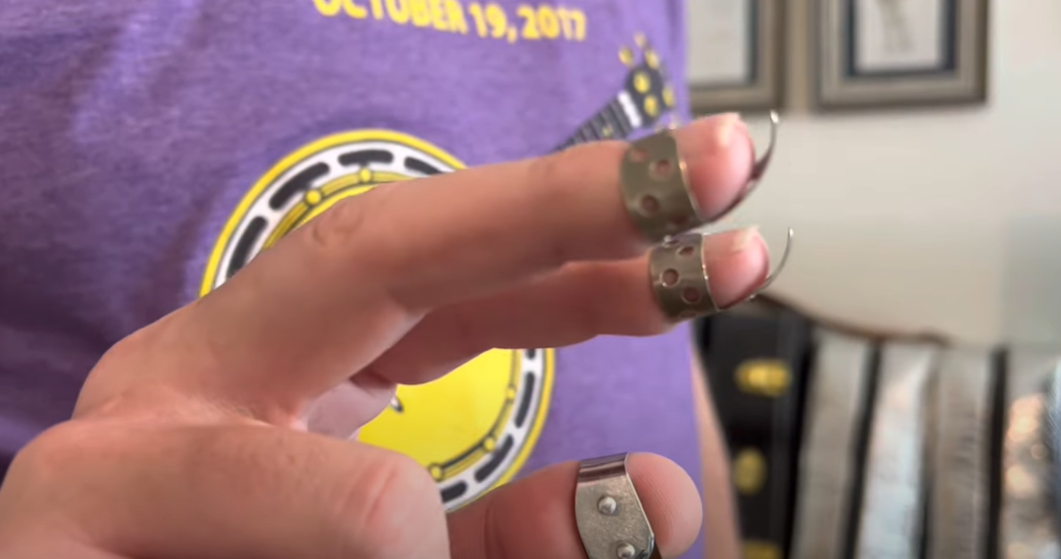
What is the correct way to wear finger picks?
To wear finger picks correctly, start by placing the thumb pick on your thumb, ensuring it’s snug but not overly tight. The flat part of the thumb pick should be facing your palm, with the picking end extending out from the side of your thumb, rather than the top. This positioning allows for better control and precision while playing.
Next, the finger picks should be placed on your index and middle fingers, with the picking ends extending over the top of your fingertips. It’s important to note that these picks are typically made of metal, which provides durability and a crisp sound. They should be worn with the picking end curving up and over the finger, with the rounded part resting against your fingernail. This placement ensures a secure grip and optimal contact with the strings.
When wearing finger picks, it is crucial to find the right balance between a secure fit and comfort. They should be snug enough to stay on your fingers even during vigorous strumming, but they shouldn’t be so tight that they interfere with blood circulation or cause discomfort. Each player’s preference may vary, so it’s encouraged to regularly adjust and experiment with the fit of the picks to find what works best for your specific banjo playing technique.
By following these guidelines and fine-tuning your finger pick placement, you’ll be able to achieve better control, tone, and overall performance while playing the banjo.
How do you position a banjo pick?
The positioning of the banjo pick is absolutely crucial for optimal playing. Once you’ve securely fitted the picks onto your fingers, it’s time to fine-tune their placement.
To start, let’s focus on the thumb pick. Find a position where it comfortably rests on the string without any unnecessary bending or twisting of your thumb. The flat part of the pick should lightly touch the string when your hand is in its most relaxed and natural playing position. This thoughtful positioning ensures effortless control and a smooth, consistent sound.
Moving on to the finger picks, their orientation is equally important. Aim to strike the strings with a motion originating from the base knuckle of your finger, rather than relying on the fingertip or middle knuckle. This deliberate positioning promotes enhanced control, speed, and tone, allowing you to express yourself fully through your banjo playing.
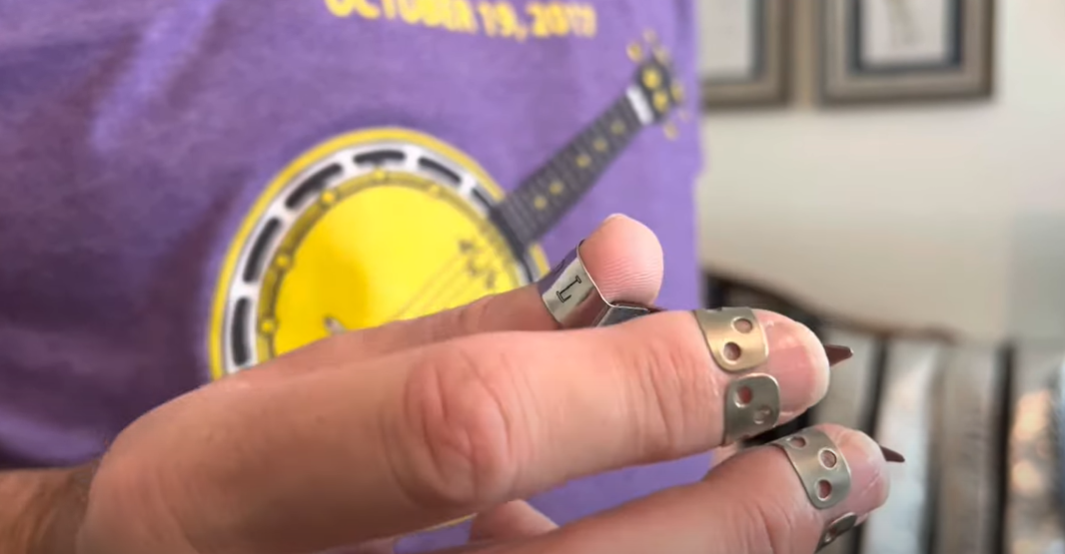
Remember, it’s vital to strike the strings using the picks and not your fingers or fingernails. Embrace the picks as an extension of your hands, enabling you to coax out the banjo’s signature sound with precision and finesse.
During your practice sessions, consider starting with slow pick rolls to familiarize yourself with the correct pick position. As you progress, you’ll naturally discover the positioning that works best for you and your unique playing style. This will become an integral part of your personal banjo technique, allowing you to create your own musical voice on this incredible instrument.
So, take the time to experiment, refine, and embrace the art of banjo pick positioning. It’s a journey that will ultimately enhance your playing and bring you closer to unlocking the full potential of this remarkable instrument.
How do you wear a banjo finger?
Wearing a banjo finger correctly is paramount to producing a crisp, clean sound when playing the banjo. Similar to the thumb and finger picks, the banjo finger should be worn snugly but not too tightly. It should be slid onto the finger until it comfortably sits behind the first knuckle, allowing for optimal control and precision in your playing.
The curve of the banjo finger should match the natural curve of your own finger, ensuring a seamless extension of your hand’s movement. The picking end should extend just beyond the tip of your finger, allowing for a precise strike on the strings. This careful alignment between your finger and the banjo finger will enhance your playing technique and overall performance.
It’s important to note that the exact fit and angle of the banjo finger may vary from player to player. Each individual’s hand shape and size can influence the ideal positioning. Therefore, it’s crucial to experiment and adjust the banjo finger until it sits comfortably and allows for a clean strike on the strings. Remember, the key to a great playing experience is finding that delicate balance between comfort and control. Don’t be afraid to make small adjustments and continue experimenting until you find the perfect fit for you.
By paying attention to these details and fine-tuning the placement of your banjo finger, you can elevate your banjo playing to new heights and unlock a world of musical possibilities. Enjoy the journey of discovering the optimal fit that enhances your playing style and brings joy to your banjo melodies.
Is it OK to play banjo without finger picks?
Yes, it’s entirely possible and acceptable to play the banjo without finger picks. In fact, some styles of playing, such as clawhammer or frailing, traditionally don’t use picks at all. However, using picks can amplify the sound and produce a sharper, brighter tone that’s characteristic of certain banjo styles, particularly bluegrass.
Playing without picks can result in a softer, mellower sound, allowing for a more intimate and nuanced playing experience. It can create a closer and more direct connection between the player and the instrument, which some banjo enthusiasts find incredibly rewarding. This direct connection can enhance the player’s ability to control the dynamics and tonal variations, adding a unique touch to their music.
On the other hand, playing with finger picks can provide a different set of benefits. The picks can enhance the banjo’s projection and volume, making it more suitable for playing in larger venues or with other instruments. The sharp attack and bright tone produced by the picks can lend themselves well to fast and intricate picking patterns, adding a distinctive flavor to bluegrass and other energetic banjo styles.
Ultimately, the choice to play with or without picks largely depends on the style of music you’re playing, the sound you’re aiming for, and your personal preference. It’s important to experiment with both ways to discover what works best for you and your banjo playing. Whether you choose to embrace the picks or opt for a more bare-fingered approach, the most important thing is to enjoy the process and express yourself through the beautiful sounds of the banjo.
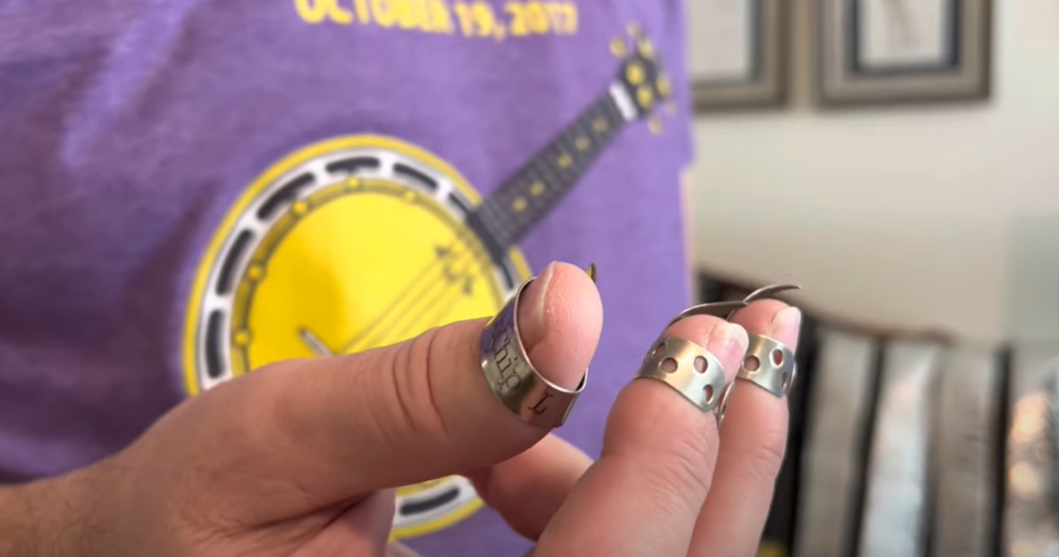
What if my banjo picks are too big?
If your banjo picks are too big, they can be uncomfortable to wear and might negatively affect your playing. This is because oversized picks may slip off your fingers or rotate while you’re playing, causing inconsistency in the sound produced and hindering your performance. Not only can this be frustrating, but it can also impact your overall playing experience.
So, what can you do if you find yourself in this situation? Consider the following solutions to ensure maximum comfort and control while playing your beloved banjo.
Firstly, you may opt to order banjo picks in a smaller size that fits you better. Numerous brands offer a wide range of sizes to accommodate different finger sizes. By choosing a pick that perfectly suits your finger shape and size, you can enhance your playing experience and eliminate any discomfort caused by ill-fitting picks.
Secondly, you can adjust the finger picks themselves. If they are made of metal, they can be gently bent for a tighter fit. However, it is crucial to exercise caution when doing so. Applying too much force may cause the picks to break, rendering them unusable. Therefore, a gentle adjustment is recommended to achieve the ideal fit without compromising the integrity of the picks.
Lastly, if you are still struggling with a large pick, you can try adding a bit of adhesive tape to the inside of the pick. This simple trick can help make a large pick fit more snugly on your finger, providing better control and minimizing any slipping or rotating that may occur during your playing sessions.
Remember, when it comes to playing the banjo, comfort and control are integral to a good playing experience. It’s crucial to find picks that fit you well and enable you to produce the sound you desire. By considering these solutions and exploring various options available, you can fine-tune your banjo playing and enjoy every strum and pluck with ease.
Useful Video: Beginner Banjo | How To Fit and Choose Your Banjo Picks
Conclusion
Mastering the art of wearing and using banjo picks is key to producing a captivating and distinctive sound from your instrument. Whether you’re a beginner just starting to explore the fascinating world of banjo playing or a seasoned player looking to refine your technique and take your sound to new heights, there are several important factors to consider.
First and foremost, comfort is crucial. Finding picks that not only fit well on your fingers but also feel comfortable in your hand is essential. The right fit will enable you to play for extended periods without discomfort or fatigue, allowing you to fully immerse yourself in the music. Don’t be afraid to experiment with different sizes, shapes, and materials until you find the perfect fit that enhances your playing experience.
Control is another vital aspect to focus on. The way you hold the pick and the angle at which it strikes the strings can greatly influence the tone and articulation you produce. Taking the time to practice and experiment with different angles and grip styles will help you find what gives you the most control and precision over your banjo playing. It’s a journey of discovery that allows you to unlock your full potential as a player.
Of course, sound quality is paramount. The right pick can make a world of difference in achieving the desired tone and projection from your banjo. Different materials, such as plastic, metal, or even natural materials like bone or tortoiseshell, can produce distinct sounds, adding depth and character to your playing. Exploring different options and finding the material that best suits your playing style and desired sound will help you craft your unique sonic signature.
When it comes to playing with or without picks, personal preference and the style of music you’re playing play a significant role. Some players prefer the crispness and clarity of using picks, appreciating the precision and attack they provide. On the other hand, others enjoy the warmth and expressiveness of playing with their fingers, relishing the intimate connection between skin and string. Experimenting with both approaches will allow you to discover the nuances and versatility each technique offers, helping you shape your playing style and adapt to various musical genres.
Remember, playing the banjo should be an enjoyable and fulfilling experience. Take the time to explore and find the right fit for your picks, and don’t be afraid to make adjustments as needed along the way. With dedication, practice, and a sense of adventure, you’ll embark on a musical journey that will lead you to the perfect combination of picks and technique, enabling you to create your unique and captivating banjo sound. Happy playing!
References:
- https://jofflowson.com/banjo-for-complete-beginners/learn-to-play-the-banjo/fingerpicking-banjo/
- https://jodyhughesmusic.com/how-to-wear-banjo-finger-picks/





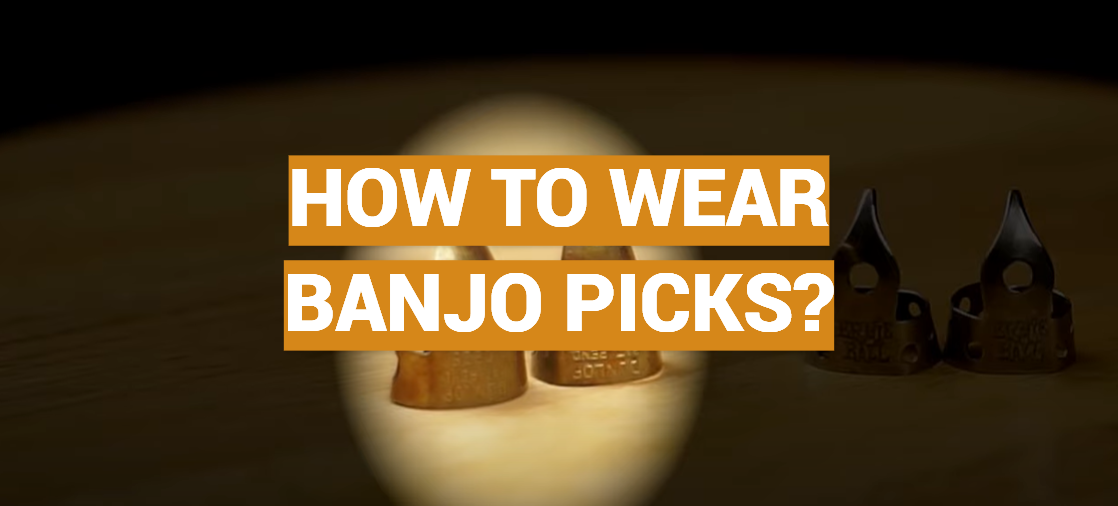




Leave a Reply